Review: #10312 Jazz Club
I’m glad to see a night out for the minifigs of Modular City — but how does the new set compare to excellent recent modulars like the Police Station and Boutique Hotel?
The latest addition to the LEGO Modular series is one of the most hotly anticipated releases for Adult Fans of LEGO. In the early days, it was one of the only sets designed with adult builders in mind, and it remains a reliable source for exceptional sets that feature innovative techniques, beautiful design, interesting colors, and a good value. This year’s set is the 17th in the series (or the 18th if you include the fan-designed #10190 Market Street set) — let’s see how it stacks up against recent additions to the series.
First Impressions
When a highly anticipated set is coming, rumors are inevitable. In the case of this year’s modular, a consensus that it would include a Pizza Parlor on the first floor, a Jazz Club on the second floor, and an apartment on the third floor. Thankfully, I did not seen any leaked photos to spoil the surprise — which allows me to speculate instead!
Thematically, I am expecting a 1930’s vibe and the architecture to support it. If the entire first floor is the pizza parlor, it’s not likely to be a cramped New York style takeaway restaurant, but rather a sit-down establishment with plush booths, dark colors, and a hint of criminal activity. After all, we got a Police Station two years ago (set in a similar time period).
Upstairs, I hope we manage to fit at least a 3-piece jazz ensemble and still have space for a few people to dance. A small bar is a necessity, even though we aren’t quite sure what Minifigs prefer to drink late at night. I would be especially happy if the Jazz Club is represented as a speakeasy, with a hidden doorway out back or from within the pizza parlor.
As for the Apartment, my expectations are low since they tend to be small – sometimes only half of the width of the lower floors. If they go that route, I would love to see a patio for entertaining with outdoor seating. Thematically, I hope that the apartment connects well with the club or pizza shop, such as the bouncer ensuring that only the hippest cats in town are given a chance to dance.
I think the exterior will be a bit darker as well, possibly showing its age with some damage on the façade. Brick seems like the obvious material, but this is a harder sell since last year’s Boutique Hotel used a lot of Light Nougat bricks. If the jazz club is a speakeasy, then the signage will focus on the Pizza Parlor, else I think the club will get top billing with a bold marquee or awning.
I need to express my continued disappointment that our Modular City still does not have a medical facility. This was already a glaring omission before COVID-19 pandemic; The LEGO Group has had plenty of time to prepare a suitable building to honor their sacrifices now that we’re approaching the three-year mark.
Box Impressions
My initial impressions with box in hand are that it missed some opportunities while exceeding others. The first observation is that the rumors weren’t all that accurate – the Jazz Club is actually on the first floor, with just a tiny Pizza Shop on the right hand side. It’s not entirely clear what we will find on the second floor, but it looks like we might have a balcony overlooking the dance floor with a small table and chairs. I am not quite sure, but it looks like the third floor is a dressing room instead of an apartment.
My prediction for a smaller 3rd floor and a patio were nearly realized, except a small greenhouse occupies that space instead. This ties together with the pizza shop nicely; who doesn’t want fresh basil on a pizza after all.
On the back of the box, we see how it looks when displayed next to the previous two sets. It feels a bit small compared to the Police Station on the left, but holds it’s own compared to the Boutique Hotel shown on the right.
When it comes to the color palette, I correctly guessed a traditional brick building, which is appears to use 154Dark Red for the second and third floor, with rusticated corners using 192Reddish Brown. I would have preferred 1White or 194Medium Stone GreyLight Bluish Gray rustication, but it’s slightly more visible than using the same dark red color.
The bottom floor is painted a 321Dark AzurDark Azure color, and we would be remiss to not metion the large vertical marquee with neon lights around the edge replicated using 191Flame Yellowish OrangeBright Light Orange. As for the pizza shop, it is less prominent due to the recessed position and the 226Cool YellowBright Light Yellow color that doesn’t stand out.
Contents
The box size is typical of the Modular Building Series. This year’s installment features the 18+ / Adults Welcome branding along the bottom of the box with a 154Dark Red background, which matches the most common color in the model.
- Box Size: 58 x 47.5 x 12 cm (22 7/8” × 18 ¾” × 4 ¾”).
- Box Weight: 3800 grams (8.4 lbs).
- Box Density: 3800 grams / 33.06 Liters = 114 g/L.
- LEGO Parts Weight: 2392 g (5.27 lbs).
The first thing that I saw after opening the right-hand side of the box was… a smaller box. The main box contained bags marked 1-8 and the smaller box contained the baseplate, instruction booklet (in a cardboard pouch) and bags numbered 9-15.
Box contents:
- Bag 1: 1x large bag (marked 342S2).
- Bag 2: 1x large bag (marked 242S2) and 1x medium unmarked bag.
- Bag 3: 1x large bag (marked 342S2) and 1x small unmarked bag.
- Bag 4: 1x large bag (marked 342S2) and 1x medium unmarked bag.
- Bag 5: 1x large bag (marked 542S2) and 1x extra-small unmarked bag.
- Bag 6: 1x extra-large bag (marked 342S2).
- Bag 7: 1x large bag (marked 242S2).
- Bag 8: 1x large bag (marked 442S2).
- Bag 9: 1x large bag (marked 741S2).
- Bag 10: 1x large bag (marked 741S2).
- Bag 11: 1x large bag (marked 142S2) and 1x small unmarked bag.
- Bag 12: 1x large bag (marked 741S2).
- Bag 13: 1x large bag (marked 142S2).
- Bag 14: 1x large bag (marked 741S2) and 1x medium unmarked bag.
- Bag 15: 1x large bag (marked 242S2) and 1x medium unmarked bag.
- 1x 32×32 baseplate (part 3811) in 194Medium Stone GreyLight Bluish Gray.
- 1x Cardboard pouch (marked 6450149): containing 342-page instruction booklet. 27.0 x 19.2 cm (10 5/8 x 7 5/8”).
Build Process
As I have come to expect from the Modular series, the build is organized into multiple phases, corresponding to the ground floor (first floor), the second floor, and the third floor. As we learn in the booklet, there are five bags for each floor.
After completing the Eiffel Tower a few weeks ago, just 15 bags and fewer than 3000 pieces sounds easy. The four features I’m most excited about are the stage, the marquee, the greenhouse, and the intricate details used for the corniced roof.
Bags 1-5: Ground Floor
Bag 1 begins in the familiar, monotonous way that’s typical of the series… It’s time to cover the 32×32 baseplate with lots of tiny tiles! Even in just the first bag, the overall layout of the ground floor starts to take shape, with a large room that will become the club, a smaller room that I expect is the customer area of the Pizzeria, and another area for the kitchen.
Speaking of the tiling, I am not super excited about the color choices for the floor of the Pizzeria — there is very little contrast between the 199Dark Stone GreyDark Bluish Gray and 138Sand YellowDark Tan tiles, creating a pattern that looks a bit dirty and muted. On the other hand, the 26Black and 1White tile in the kitchen is a classic combination which looks clean and stands out.
Moving to the Second Bag, we finish the tile floor for the club, and move on to the walls, especially in the pizzeria. We build a lovely assembly for the oven containing a 4x3x1 ⅔ Mudguard (part 1846) in 26Black. I do question whether wood-fired pizza is period appropriate or not, but it looks good.
As we build up the walls, we also tuck a tiny bathroom under the stairs. We wrap this bag up with a module containing the stage which fits nicely into the corner. Onto the stage, we put a stand holding a saxophone, and a nice looking drum kit which uses a 2×2 radar dish (part 4740) in 310Metalized GoldGold for a cymbal.
Bag 3 is when we add a lot of interior furnishings, including three tables and six chairs at the Jazz Club, and the countertop with both a complete pizza and the ingredients required to build the next one. We also spend a lot of time building the walls a lot taller, as well as finishing the narrow staircase which will lead to the second floor.
The focus on Bag 4 is on building up the wall, especially the front façade. We start with a bay of windows on the left side, and a billboard in front of the staircase. We continue adding a relatively complex bay of windows in front of the Pizzeria, which utilizes some hidden technic components to achieve the half-stud offset for the centermost column along the front. We finish the stage by adding a layer of tiles along the top with just a few exposed studs, making it easy remove and re-attach the next floor on top.
The fifth and final bag of the first floor is an interesting one. We start off with some smaller details including a removeable row of lighting above the stage, the red/green/white awnings on the pizzeria, some exterior lighting, and a curious 325Lavender sign for a Tailor shop.
The major assembly on this stage is the front door of the Jazz Club, which is built as a single large 7×7 module that will be installed at a 45° angle. It attaches to the rest of the model using just a single jumper on the bottom, and two 1×8 tiles on the top. The angled entrance doesn’t stand out on the box cover (because it is dwarfed by the marquee that will appear above it), but it’s a nice detail that adds some dynamism to the composition. I did notice that there’s a slightly larger than usual gap between both sides of the module and the rest of the walls. At roughly ¼ the thickness of a plate, it won’t be visible unless you decide to add lighting to the interior of the model.
Build time: 115 minutes. (Bag 1: 20 minutes, Bag 2: 24 minutes, Bag 3: 25 minutes, Bag 4: 28 minutes, Bag 5 18 minutes.)
Bags 6-10: Second Floor
The second story begins in Bag 6, with an assembly that appears to only cover the jazz club side of the model. I can’t yet tell if it will be attached to the second story of the pizzeria, or if they will be separate assemblies. We build a floor that is two plates thick, and the beginnings of the second story walls which are in the popular 154Dark Red color.
The only interior décor that we added so far is a brick-built swivel chair behind a large round desk, complete with a brick-built rotary phone. On the left hand side of the desk we have a green desk lamp, perhaps inspired by the green banker’s lamp which was introduced in 1909. Whoever sits at this handsome desk (thinks that they are) rich and/or important!
Into bag 7, we add a lot more height to the walls. We also add a 2×2 pixel artwork on the left wall, and the railing overlooking the stage which will be right below. One interesting detail on the right wall is that 1×1 Technic bricks are hanging off the right wall – which I’m confident will connect to the second story of the 226Cool YellowBright Light Yellow pizzeria building. Whether this is used to connect the two walls discretely without overlapping colors, or if it is employed to allow you to separate the buildings later is not clear.
Bag 8 is quick, adding the doors, some of the windows and the rest of the walls. We do see an interesting technique for the front windows, which exploits the fact that certain brackets are ½ of a plate thick. You can add a plate and a tile to perfectly fill a gap that is one brick wide. This allows a gap that is four studs wide to be filled with a colorful stained glass window assembly that is just two studs wide.
We finally get to learn why there was a tailor sign on the ground floor — in Bag 9, we build a small yellow room directly above the pizzeria. The room itself is pretty bland, but there’s a selection of nice brick-built furnishings for the tailor’s small business.
The main highlight is the clever brick-built sewing machine, which has a foot pedal, wooden work surface, and the familiar black painted cast iron machine on top. The back wall has a cabinet with four rolls of cloth, with the red roll coming unfurled. A classic white mannequin rounds out the furnishings.
I’m excited to finish the second floor with the 10th bag. This begins with completion of the narrow staircase to the third floor and the last few layers of brick on the right side of the model. The windows on the front façade of the tailor shop mirror the styling of the pizzeria below it. The process ends with adding tile along the top edge to make it easier to attach and remove the third floor. Lastly, we add some cute hanging flower baskets which look blocky up close, but look good in practice.
Build time: 87 minutes. (Bag 6: 22 minutes, Bag 7: 17 minutes, Bag 8: 16 minutes, Bag 9: 13 minutes, Bag 10: 19 minutes.)
Bags 11-15: Third Floor
The third floor begins with Bag 11 where we start off by building the floor of the left-side of the building. We add onto the floor with two layers of 154Dark Red brick for the exterior. I do want to talk about color palette here, though. I am not a fan of how the 154Dark Red wall looks next to the 192Reddish Brown which is used to mimic a wooden railing next to the staircase down to the second floor. It’s a color combination which does not read well in practice: they are too similar to stand apart from each other, but different enough to clash.
Another bold use of color is in the 24Bright YellowYellow couch with 140Earth BlueDark Blue cushions. It is a nice-looking plush couch, but it feels awfully bright for an otherwise earthtone room. This continues to reinforce my feelings that the color palette is a bit too broad in this set.
Bag 12 is more of the same, adding several layers of bricks to the walls, trimming out and installing windows in the front using the same technique as the previous floor, and three windows in back. The one fun and unique detail is the dressing wardrobe and mirror, which has glamorous lights around three sides and a Metallized 2×4 tile serving as a mirror. It isn’t quite shiny enough to show a reflection, but it’s obvious what it is meant to represent.
It’s time for the roof in bag 14, and I’m excited to see how the architectural details along the front edge come together. The back edge and sides are just basic bricks, but the front edge is intricately detailed using a range of SNOT techniques. The most interesting bit is in the center, which is built upside-down. It looks cool, but I do have a problem with the central spire — because it’s connected with just one stud, it falls off whenever I try to move the model or attach or remove the roof to look inside.

There’s a squirrel hiding in a nest on the roof, and an access panel to try and scare the squirrel away.
The Jazz Club sign is straightforward, employing a couple different components to achieve the “neon” light around the edge, including most noteworthily the sausage element at the top and bottom. Printed tiles feel like cheating, but they look pretty good. I do wish there was a bit of space between the ‘Z’ and ‘C’ — it looks like “JAZZCLUB” as one word.
The last bag builds the roof of the yellow building, onto which we add a cute little greenhouse. The tomato plant looks great and makes a lot of sense given the pizzeria on the first floor. The instruction booklet indicates that the carrots are for the magician’s rabbit.
We also put all the remaining details in place in this bag. This includes the delivery driver and his scooter, as well as the table and chairs out front so customers can eat their pizza. It has an umbrella for sunny days and bad weather, since there’s no seating inside the small shop. We learned in a roundtable discussion with design lead Jamie Berard that the umbrella is a new print, but it’s an intentional homage to #6350 LEGO Pizza To Go (1994).
Build time: 93 minutes. (Bag 11: 15 minutes, Bag 12: 16 minutes, Bag 13: 19 minutes, Bag 14: 26 minutes, Bag 15: 17 minutes.)
Parts
Big sets like this can be a great source for parts in less common colors. The Jazz Club includes a lot of 154Dark Red for the second and third floor, and some 321Dark AzurDark Azure and 38Dark Orange for the first floor. Both floors of the pizzeria provide a rich source of 226Cool YellowBright Light Yellow parts (a color that was downright rare before the release of #10271 Fiat 500 in 2020).
Rather than highlight every newly recolored part in this set, I wanted to highlight two new parts that are of widespread appeal, and give a coser look at the 7 minifigures in this set.
New Parts
4x3x1 ⅔ Mudguard (part 1846)
This is a completely new part. You only get one of them and it comes in 26Black. It’s used to create the curved front of the wood-fired pizza oven.
The geometry of this part is interesting. It is less than 2 bricks tall, resulting in a perfect half-circle with a 2-stud radius. (5 plates in height is the same length as two studs wide.) I do not have two of them, but I suspect that they would line up perfectly when one of them is inverted.
[The new mudguard] – It’s definitely from another team … we’re trying to make more versatile elements that can be used in many places. … that generic shape that you’re seeing … is a very deliberate attempt at trying to create more of these core elements that can be used for anything.
Jamie Berard
1×2 jumper ½ round (part 1745)
This part was introduced in #71408 Peach’s Castle – Expansion Set in 21Bright RedRed, and this is the second set to include it. This set includes 6x of them in 194Medium Stone GreyLight Bluish Gray, which are used for detailing above and below the second story window frames.
When there’s a new element that is so delicious as this little jumper plate? You could be sure that people have noticed it. I don’t want to give away anybody else’s thunder, but it’s a fun element to build with.
Jamie Berard
Minifigures
The minifigures in this set are not inspired, but people buying the set will be pleased to see that we get 8 minifigs this year — that’s three more than in 2020/2021. (#10224 Town Hall also contained 8. #10255 Assembly Square had 9, making it the only modular to include more minifigures than this set.)
The reason we needed so many minifigs is to tell all of the stories packed into this set. The smaller yellow building contains the Pizzeria which requires an older chef with a thick white beard and a delivery driver who can deliver a pizza in record time while wearing his sporty leather jacket. Finally, we have the tailor who works upstairs, and is no doubt kept busy making fancy costume dresses for the jazz band.
The Jazz Band has a drummer and stand-up bassist who are both wearing the same pants and torso. The bassist has a hearing aid which is great for diversity/inclusion (but isn’t period accurate since hearing aids in this era required external battery pack). The singer is dressed in an elegantly embroidered floor-length black dress. The club manager has a floral print beneath a light blue jacket, and we can’t forget the magician who performs earlier in the evening.
As for the six seats in front of the stage, you will need to borrow figures from other modulars to watch the show!
Value
In most cases, you should assess the value of a LEGO set based on how excited you are about the model and decide if it feels like a fair price for what you are getting. That said, there are some objective measures we can use to assess value as well.
| Set | Price | Number of Pieces | Weight of model | Weight-per-piece | Price-per-piece | Price-per gram |
|---|---|---|---|---|---|---|
| #10312 Jazz Club (2023) | $229.99 | 2899 | 2392 g | 0.82 g | $0.079 | $0.096 |
| #10297 Boutique Hotel (2022) | $229.99 | 3066 | 2380 g | 0.78 g | $0.075 | $0.097 |
| #10278 Police Station (2021) | $199.99 | 2923 | 2602 g | 0.89 g | $0.068 | $0.077 |
| #10270 Bookshop (2020) | $199.99 | 2504 | 2085 g | 0.83 g | $0.080 | $0.096 |
It turns out that #10278 Police Station is the best value based on both price-per-piece and price-per-gram. It helps that it retained the lower 199.99 price point and also has the heaviest pieces on average at nearly 0.9 grams per piece.
This year’s #10312 Jazz Club is almost identical in value to the other two remaining sets based on both price-per-piece and per-gram. Because it does not stand out by having especially good or especially bad value, I have focused on subjective details in the final assessment below.
Conclusion
#10312 Jazz Club is a nice model that’s rooted in big cities in the United States, and the architectural details support this. In a recent roundtable with the design lead, he reinforced this.
I definitely know he was influenced by Chicago and New York areas, it’s just any of those bigger urban cities that would actually support nightlife and this whole music scene.
Jamie Berard
This modular stands out on a crowded street thanks to bright colors and a substantial height, but those bright colors are divisive. The main colors in this model are 154Dark Red, 226Cool YellowBright Light Yellow, and 322Medium AzurMedium Azure. Roughly speaking, these three main colors are Red, Yellow, and Blue which are the three primary colors in pigment. They form what is called a triadic color scheme. This is a high contrast color scheme that has a strong precedent in art and design. It does stand out compared to many of the previous sets in the Modular Building Series. While I was cautiously optimistic about the color scheme at first, I do find it a bit distracting from the rest of my street scene.
In the nearly 5 hours of building time, #10312 Jazz Club has a lot to offer. Unlike something like the Eiffel Tower, it’s a constantly changing experience without many boring or repetitive parts. It features more minifigs than almost any other set in the series, it includes some new building techniuqes for the angled front entrance and moulding, and includes excellent storytelling opportunities thanks to three different businesses and two sets of performers.
Compositionally, it can’t compete with something as dynamic as last year’s Boutique Hotel, but it is a nice model with a primary form on the left and a supporting structure which is recessed and on the right. As noted earlier, the color palette presents some issues for me, but the brighter colors will appeal to other people. It’s ultimately a very good LEGO Set, but due to the exceptional quality of other sets in the Modular Building Series it’s about average compared to recent sets in the series.

After some experimenting, I think the Jazz Club looks best with the two halves of the Bookshop set on either side.
Of the four modulars I own, it is better than #10270 Bookshop, but not as good as #10297 Boutique Hotel (which has an amazing angled composition) and #10278 Police Station (which has an even richer story embedded in the model and a more striking architectural form). The large central building, storytelling richness, and large cast of minifigures earns this set the Recommended (4/5 star) rating.

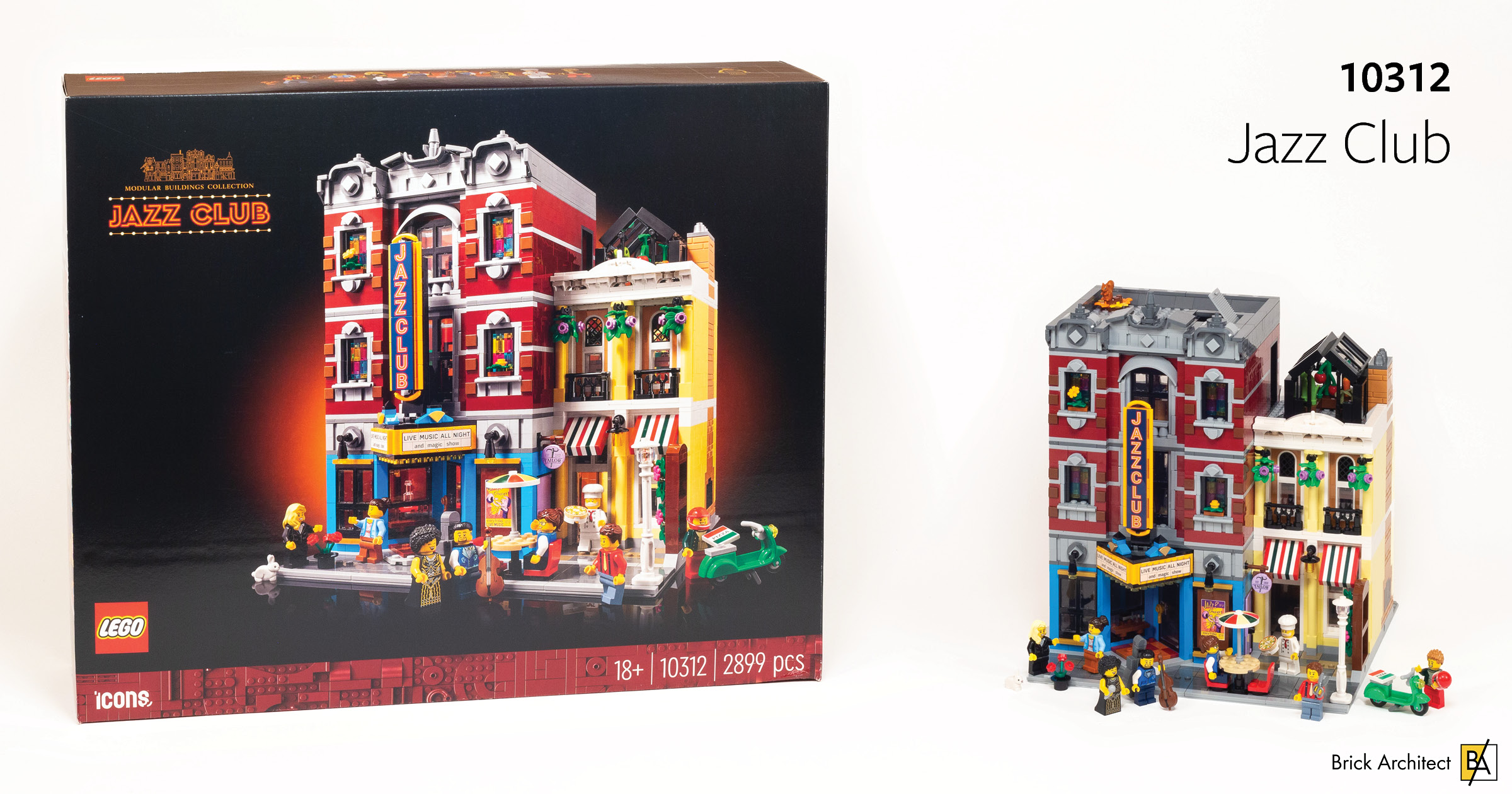
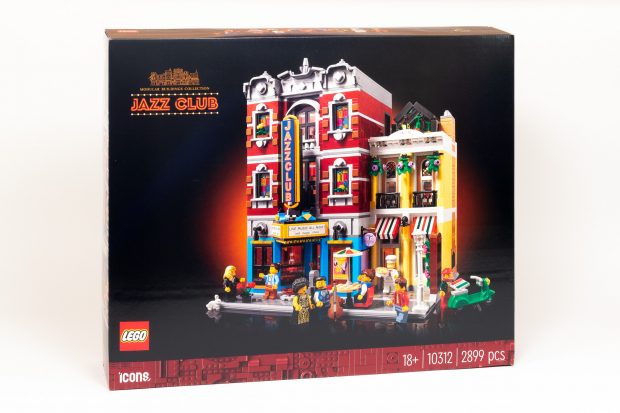
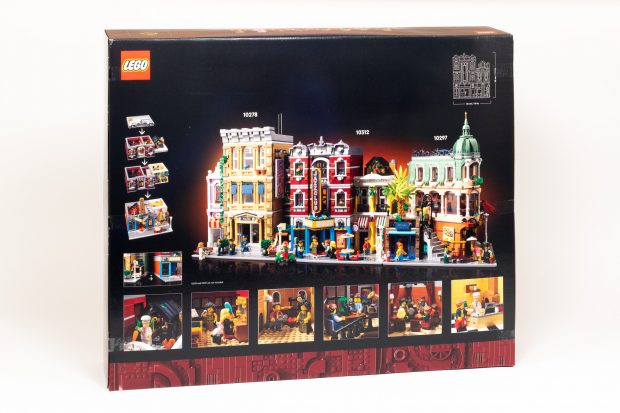

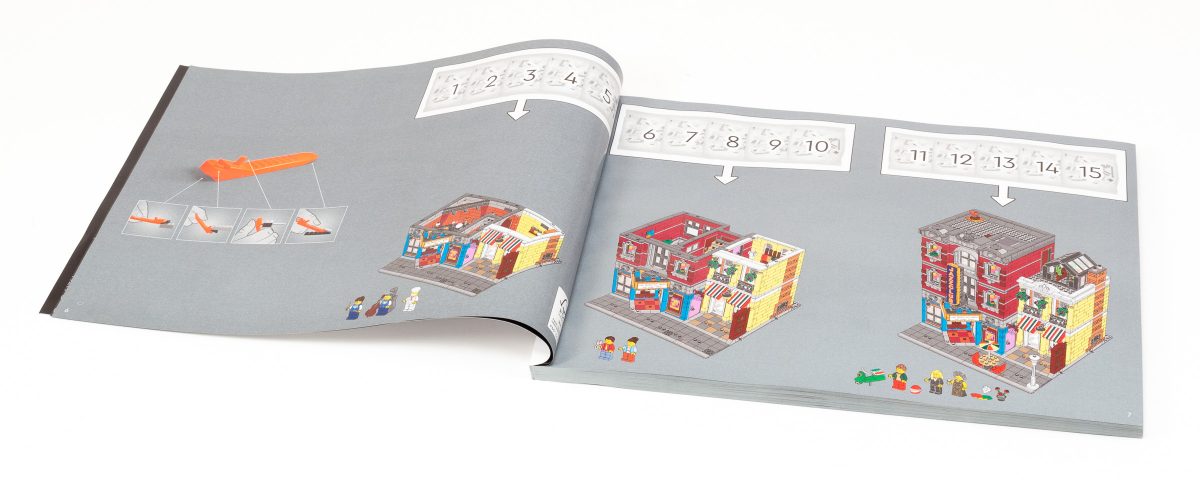

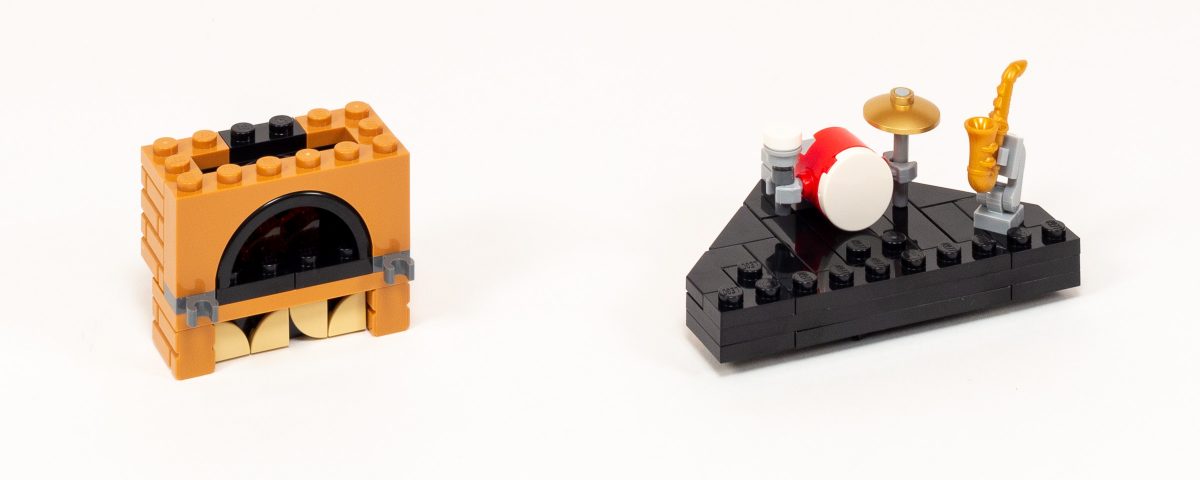
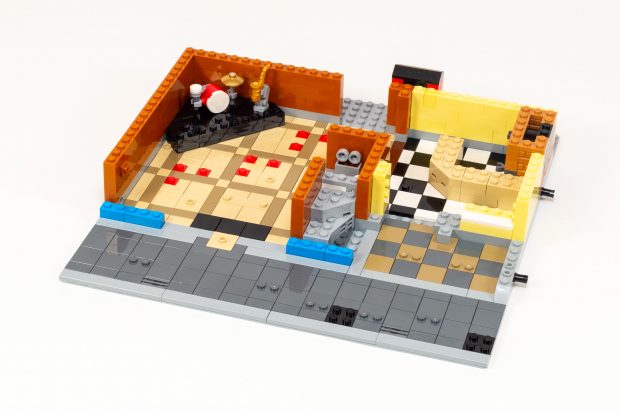

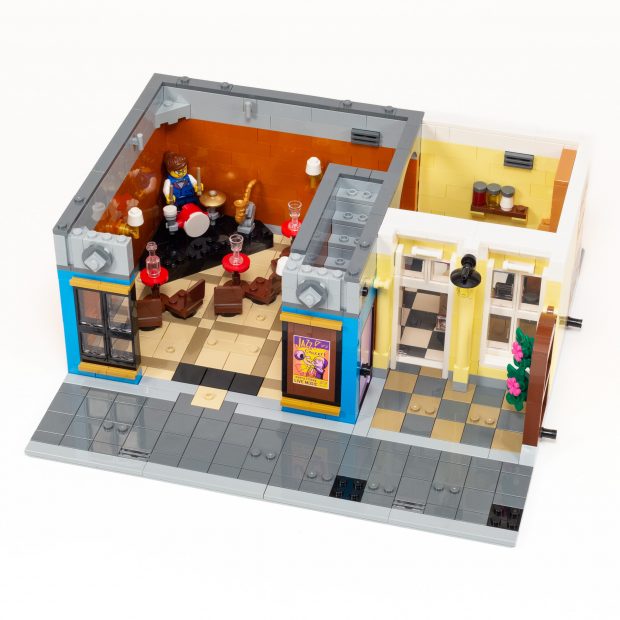
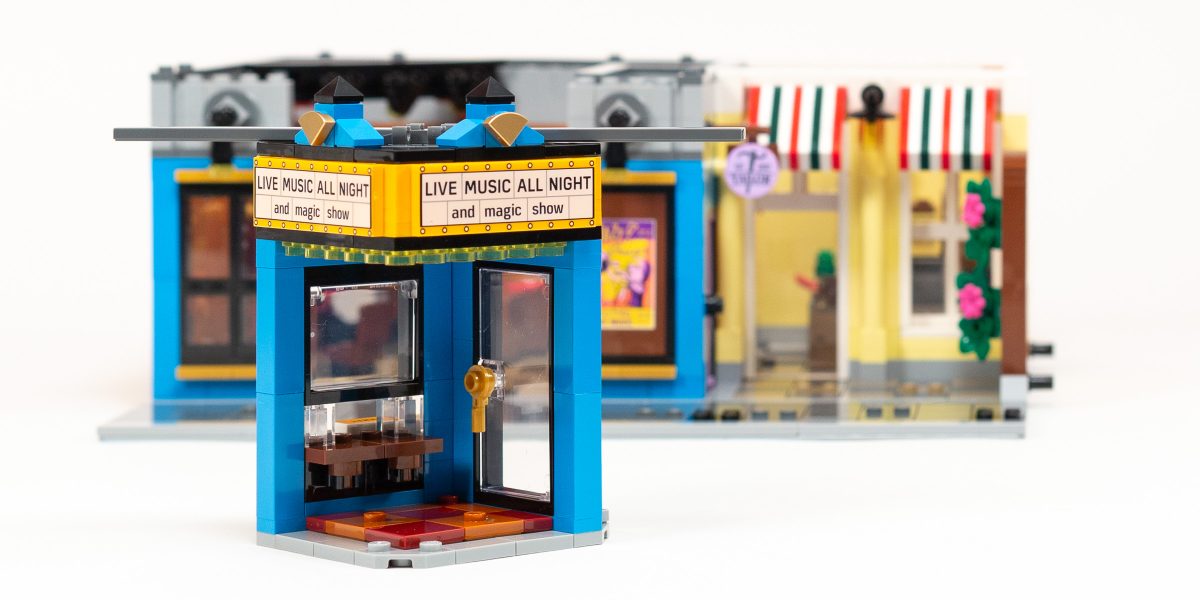

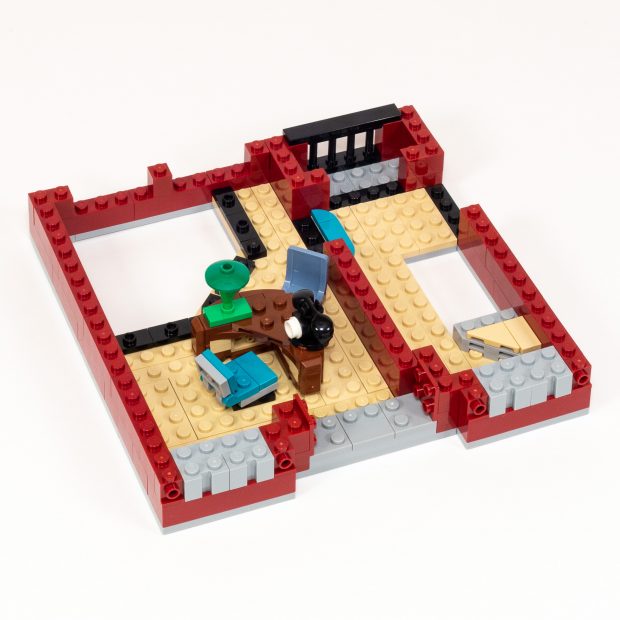

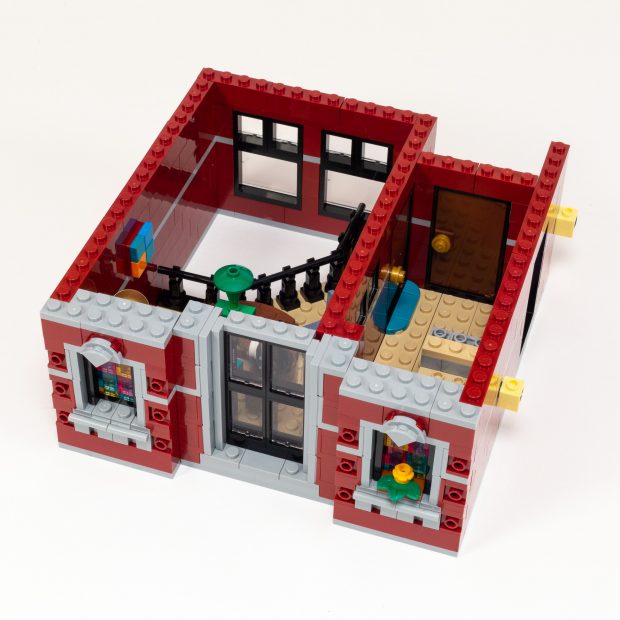
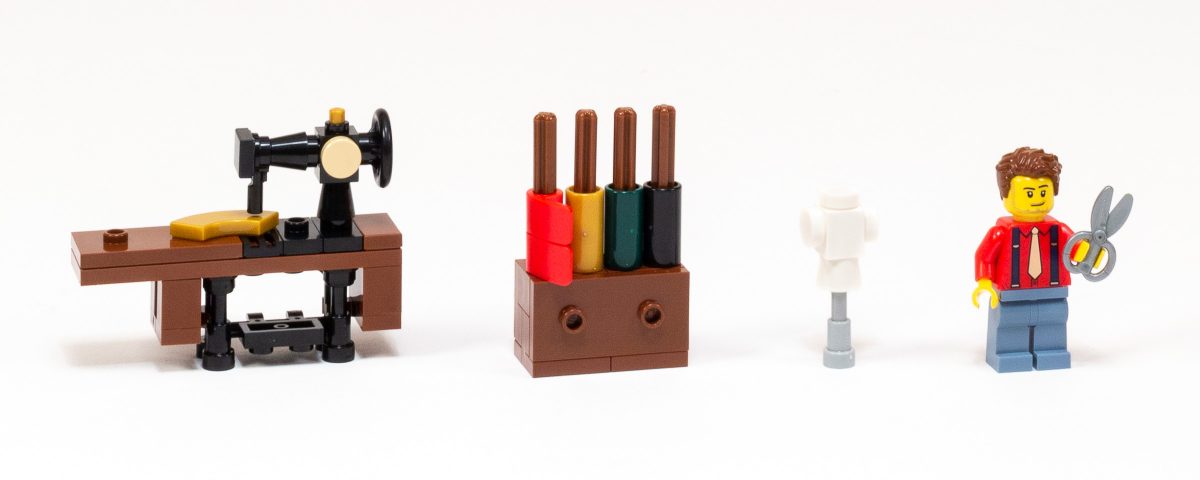
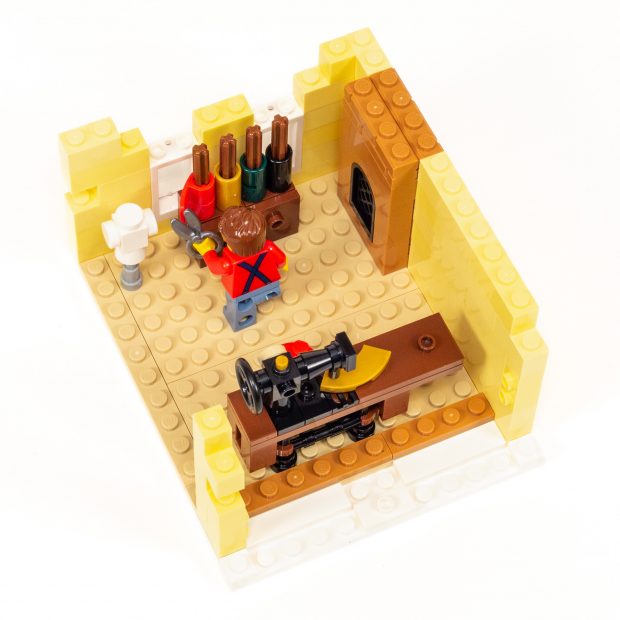

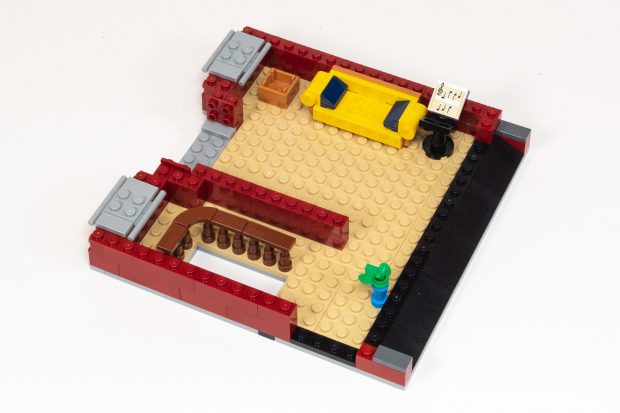
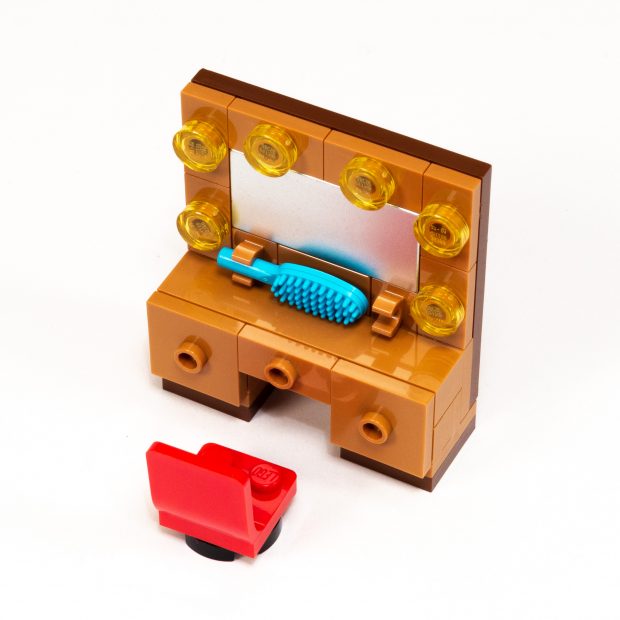

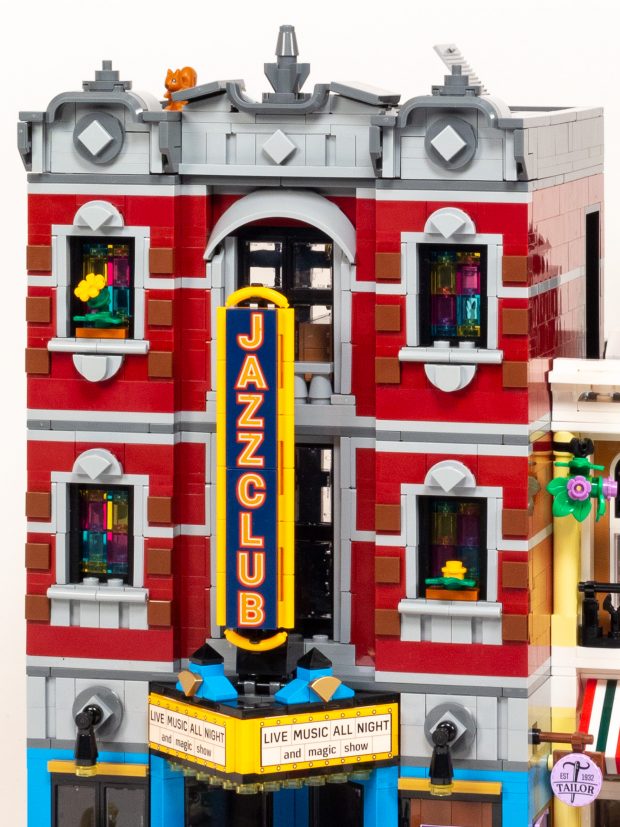

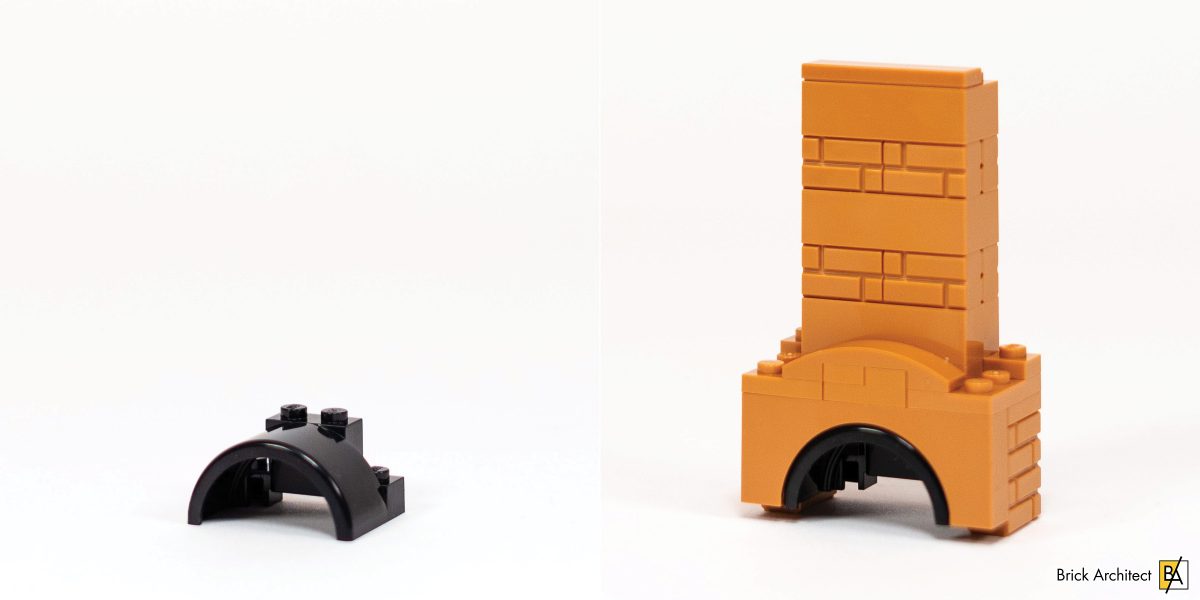
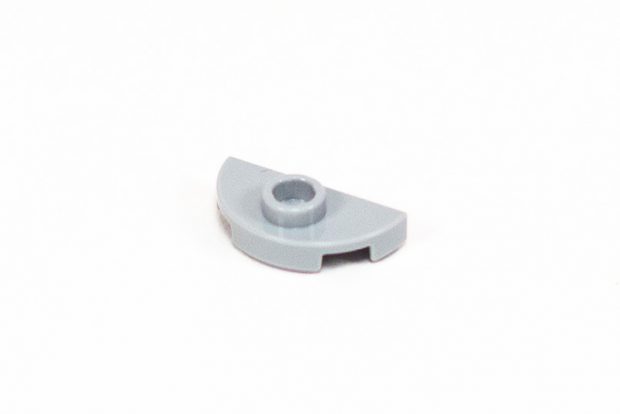
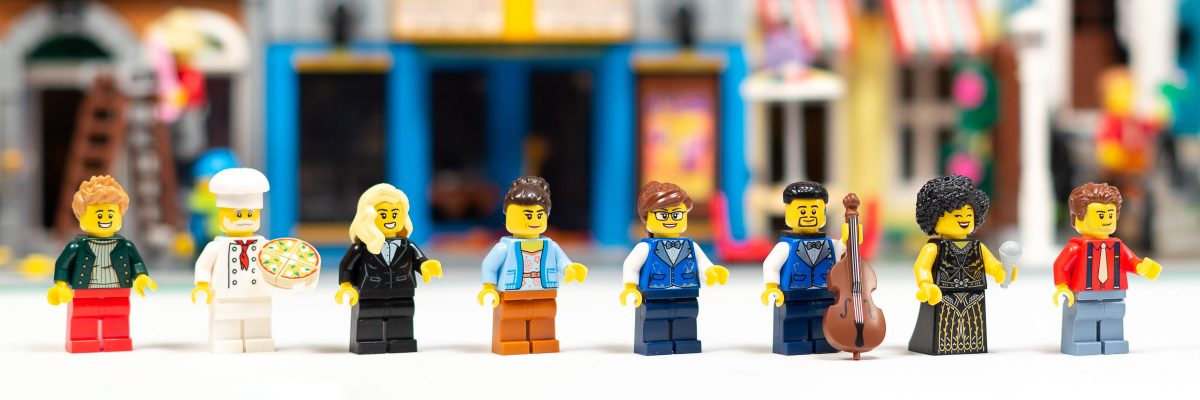
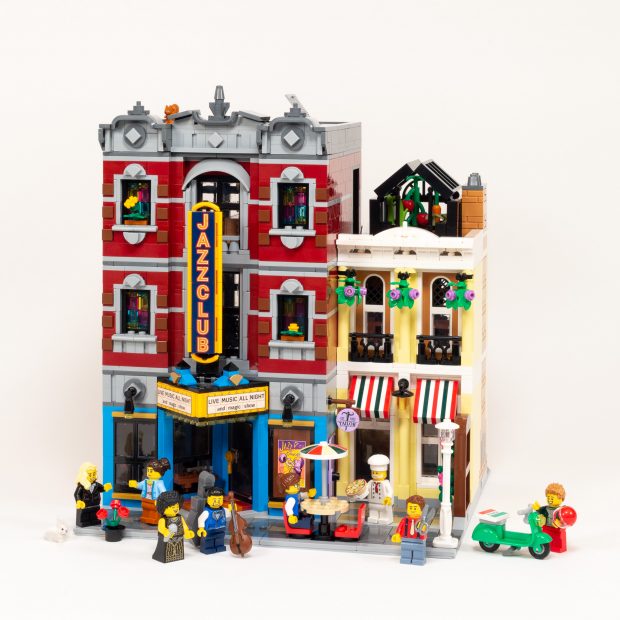
A fantastic, detailed, and balanced review! I especially appreciate the extra work you put into comparing this on a “PRICE-PER-PIECE” and “PRICE-PER GRAM” basis. After examining the table it seems my feelings were correct, this set is not grossly overpriced, it is definitely within the zone of reasonableness when compared to other recent modulars.
I’m so happy to hear that this additional analysis is valuable to you. It’s a lot of extra work, but I love how it adds objective analysis to otherwise subjective review.
That’s a really good review very detailed and pleasant to read. Like every year the modular is a “must buy” and this one will be purchased with a nice GWP or a good promotion.
What i like in this set is the mix of vintage and modernity, the use of classic space parts in grey for the windows and the one at the top of the roof; the rocket part. I see a new pizza slice (margharita)…
The palette of colors is really eye catcher for me, the green touch is a nice touch and the fluidity between the rooms looks excellent.
Anyway, i love this set.
PS : is the trumpet on the sign an Easter egg about LEGO Western ???… 😀
As always, a great review, thanks Tom. The way you choose to photograph the subject matter really helps you get a feel for the set.
Came here from Your link on Brickset. 🙂 Great job with review. For You contrast colours are con, but for many it will be asset. In my opinion biggest problem in this modular is lack of details and boring shape.
I really like that You compare weight of sets. Piece count can be misleading. It shows how good Police Station is. Considering how great in real life it’s presenting I think it had not enough “glory”.
I’m glad you find the part/set weight comparisons valuable. It’s a lot of extra work, but it gives people some better objective measures of relative value!
Would be interesting to see it next to the Palace Cinema. The signs might either complement each other very well or clash badly
I’m also curious to see the two placed next to each other to create an “entertainment district”, and maybe with the Parisian Cafe on the other side. Unfortunately, I do not have a Palace Cinema so we will need to wait for someone with a more extensive modular collection to see how it looks.
—Tom